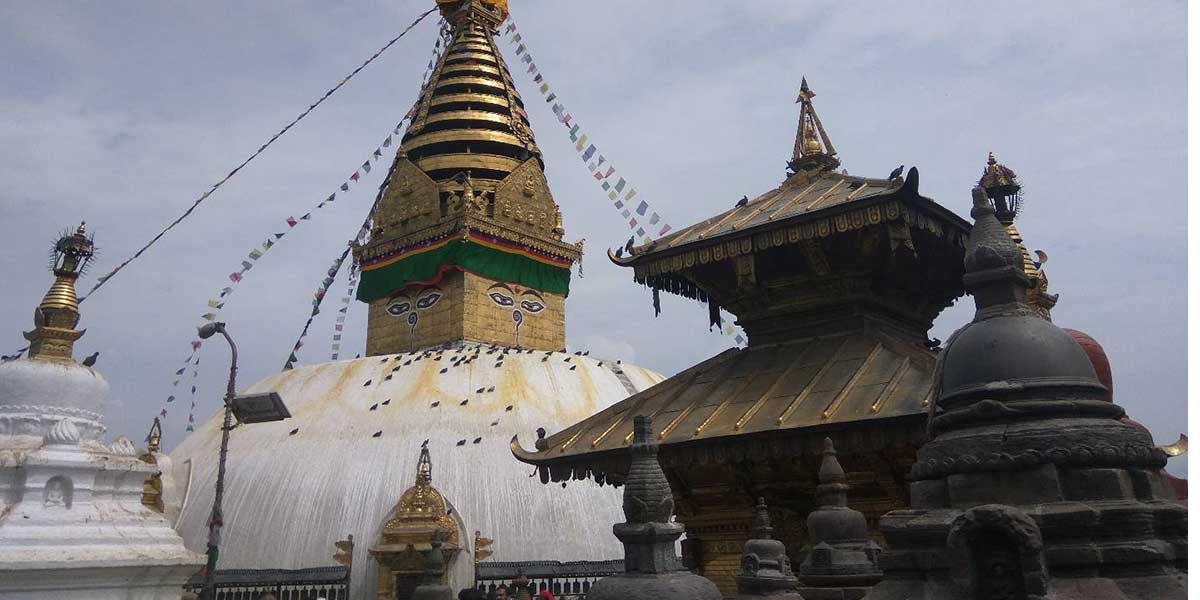
Ancient beliefs and rituals have great influence over the lives across Nepal: so do religious ideology. The pristine lakes and peaks are regarded as the abode of Gods. People, here, are strictly adhered to cultural practices, from daily rituals to frequent festivals. This has become a part of the existence of Nepalese. Saturated mostly by the Hindus, Nepal is mentioned several times in the epics of ancient Vedas. In fact, Nepal was a Hindu Kingdom until 2007, when the King was dethroned by People’s Movement II.
However, Buddhists, Muslims, Christians, and Bons still hold a respectable position in society. Religious tolerance has been a National asset since forever. Indeed, no religious riots are ever recorded in the thousand’s year-old history of Nepal. Temples range from the rustic villages to the most developed cities. Monasteries adorn the Himalayas. While, mosques and Churches are thinly scattered, mostly in the lower-Terai.
The majority of Nepalese follow Hinduism, which is, probably, the oldest religion in the world. According to Hinduism, everything in this universe is interconnected: so are our actions of the past life. Natural catastrophes are believed to be the revenge of God. In fact, there are thousands of Hindu gods (330 million as mentioned in the epics of ancient Vedas) and the worshipping dogmas vary from one god to the next. Every house has its own supreme god, known as ‘Mul Devata’, to whom the whole family bestows extreme devotion. During the ‘Pujas’, a religious activity, a priest (typically brahmin) chants the Sanskrit incantations (Mantras) for the well-being of the family.
Of all, there are three main gods: Brahma (the god of creation), Bishnu (the god of Preservation), and Shiva (the god of destruction). They are worshipped in different ways as per the worshipper’s caste and culture. Also, they appear in different forms.
Brahma, four-headed, is rarely visible. Although his statues are personified and show him as four-headed, according to Bhagavad Gita, those heads represent Mann (mind), Buddhi (intelligence), Chitta (senses), and Ahamkara (Ego). Whoever has control over these four aspects of Brahma is believed to have ‘Paramatma Darshan’, understand the infinite powers of a god.
Bishnu, on the other hand, is the preserver of whatever Brahma has created (For instance: river, land, landscapes, and everything). According to the epics of Hinduism, Bishnu has incarnated several times (over 10): Krishna, Buddha, and others. Whoever you worship, you are praising the Bishnu. ‘Sudarshan Chakra’, the spinning wheel, is the trademark of Bishnu as featured in the pictures.
While, Lord Shiva has special powers of regeneration and comes into different forms, such as Mahadev, or the dancing Nataraj. Pashupati (the lord of Beasts) and Bhairav is the most destructive form of Shiva. He wraps the tiger’s skin over his hip and snake in his neck. His wife is Parvati, who also has many forms, Kali and Durga.
Noticeably, Buddhism is prevalent more in the northern sects of Nepal (upper Himalayas) and the Kathmandu Valley, while a handful of followers are still found in the lower-Terai. Buddhists go to a monastery (gompa), primarily, for religious work and to learn Buddha’s practices. Such places are adorned with the brilliant artistry and iconography of Buddha.
The Buddhist images inside the monastery are, indeed, not gods, but the icons that are used to direct one’s mind towards the true path of learning through meditations. Those fearsome artworks remind the follower of their darker side. In fact, images play a crucial role in provoking the mind’s energies and directing them in a particular direction.
Buddhism is pursued as the philosophy of living and is taught (these days) in the large universities of the world, such as Stanford University. Adherents seek peace of mind and strive to attain the placid state, ‘Nirvana’, which is achieved by continuous good actions and thoughts. Hindus consider ‘Buddha’ as an incarnation of the god ‘Bishnu’.
Buddhists don’t believe in tangible materials. They are more inclined towards personal spiritual development and believe that nothing is fixed or permanent in the world: everything changes. According to the epics of Buddha, the wrong belief of permanence is the root cause of suffering. One who understands this and works accordingly finds him happy and content (enlightenment) throughout his life. The path to enlightenment is through rigorous practice in the development of morality, meditation, and wisdom.
The Bon religion is believed to have originated from Tibet (no factual evidence to support this argument). However, the Olmolungring, a legendary place from the Nazik, is the probable place of origin of Bon because the place name ‘Tazik’ appears in Bon literature. Bon’s followers seek the eternal truth and reality of life as do Buddhists. They revere the heavens and mountain psyche, including the natural phenomenon such as ‘thunder’ as the spirits of natural powers.
The ancient Bon believed that life originated from an egg. The multitude of animal-headed masks of demons and deities hints at the exciting culture of the Bon people. The protector Khyung bird is revered by the legendary Bons. Their sacred symbol is ‘Yungdrung’, which is very much similar to that of Tantric Buddhists’ Dorje, a thunderbolt scepter. However, they do use the swastika symbol of Hindus, but in the opposite direction. Like Buddhism, they also have faith in the prayer flags.
Bon people are very few in number and are settled particularly in the Dolpa region of Nepal. In the Kathmandu valley, one Bon monastery could be found around the great Swayambhunath Temple.
Shamanism is a unique religion with awe-inspiring religious beliefs and practices. Because of their magical and eye-catching rituals, scholars from a wide variety of disciplines such as anthropologists, archaeologists, historians, religious studies scholars, philosophers, and psychologists have come to explore this religion in depth. Shamans have their own ways of providing medical treatments. Oracles (Jhankris) perform these practices. To study more about Shamanism, Dolakha of Nepal is the best place to scratch your head-on.
Islam, Christianity, and Sikhism are other religions practiced by Nepalese inhabitants.